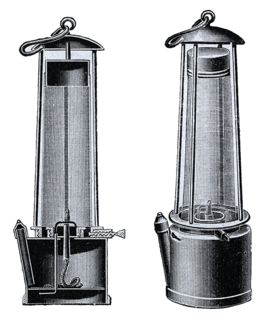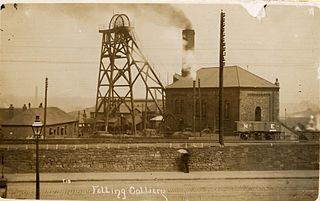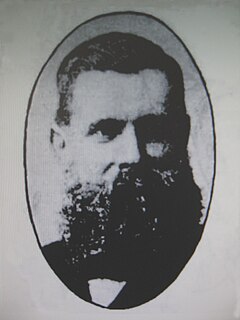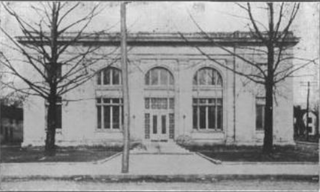 W
WMine safety is a broad term referring to the practice of controlling and managing a wide range of hazards associated with the life cycle of mining-related activities. Mine safety practice involves the implementation of recognised hazard controls and/or reduction of risks associated with mining activities to legally, socially and morally acceptable levels. While the fundamental principle of mine safety is to remove health and safety risks to mine workers, mining safety practice may also focus on the reduction of risks to plant (machinery) together with the structure and orebody of the mine.
 W
WAmerican Mining Congress v. Mine Safety & Health Administration, 995 F.2d 1106 (1993) is a decision by the United States Court of Appeals for the District of Columbia Circuit concerning the issues of administrative law and agency oversight.
 W
WThe Black Lung Benefits Act (BLBA) is a U.S. federal law which provides monthly payments and medical benefits to coal miners totally disabled from pneumoconiosis arising from employment in or around the nation's coal mines. The law also provides monthly benefits to a miner's dependent survivors if pneumoconiosis caused or hastened the miner's death.
 W
WA blasting mat is a mat usually made of sliced-up rubber tires bound together with ropes, cables or chains. They are used during rock blasting to contain the blast, prevent flying rocks and suppress dust.
 W
WBoothstown Mines Rescue Station which served the collieries of the Lancashire and Cheshire Coal Owners on the Lancashire Coalfield opened in November 1933 on a site in Boothstown, close to the East Lancashire Road. The mines rescue station is Grade II listed and at the centre of a conservation area. It replaced mines rescue stations at Howe Bridge, Denton, St Helens and Burnley.
 W
WA cap lamp is a lamp worn on the head or helmet. It is mostly used in an underground environment, like mines or during outdoor activities, e.g. climbing.
 W
WA Dahlbusch Bomb is an emergency evacuation device for use in mining. In its original form it is a torpedo-shaped cylinder with a length of 2.5 metres, developed to transport trapped miners through boreholes after mining accidents. It does not contain explosive: it was called a "bomb" because of its shape.
 W
WThe Davy lamp is a safety lamp for use in flammable atmospheres, invented in 1815 by Sir Humphry Davy. It consists of a wick lamp with the flame enclosed inside a mesh screen. It was created for use in coal mines, to reduce the danger of explosions due to the presence of methane and other flammable gases, called firedamp or minedamp.
 W
WEscape respirators are a portable breathing apparatus or mask that regenerates breathable air to help provide respiratory protection for emergency escape from areas containing harmful gases or IDLH atmospheres. There are two types of escape respirators: air-purifying escape respirators and self-contained escape respirators. Often times, these respirators utilize an easy-to-don hood and some sort of supplied air tank or filter attachment that cleans the incoming air for the user. Escape respirators are not to be used for anything other than escaping a contaminated environment. Escape respirators are not to be used for general or everyday respiratory protection. A cross-breed between a gas mask and a respirator, the escape respirator is used extensively in the mining and chemical industries, and by emergency responders. Escape respirators should be certified by a national authority analogous to the United States' National Institute for Occupational Safety and Health for escaping from the atmosphere in which the respirator is manufactured for.
 W
WThe Federal Coal Mine Health and Safety Act of 1969, U.S. Public Law 91-173, generally referred to as the Coal Act, was passed by the 91st United States Congressional session and enacted into law by the 37th President of the United States Richard Nixon on December 30, 1969.
 W
WThe Federal Coal Mine Safety Act of 1952 is a U.S. law authorizing the federal government to conduct annual inspections of underground coal mines with more than 15 workers, and gave the United States Bureau of Mines the authority to shut down a mine in cases of "imminent danger." The Act authorized the assessment of civil penalties against mine operators for failing to comply with an order to shut down or for refusing to give inspectors access to mine property. The law did not authorize monetary penalties for noncompliance with the safety provisions. In 1966, Congress extended coverage to all underground coal mines.
 W
WThe Federal Mine Safety and Health Act of 1977 amended the Coal Mine Safety and Health Act of 1969. It can be found in the United States Code under Title 30, Mineral Lands and Mining, Chapter 22, Mine Safety and Health.
 W
WThe Federal Mine Safety and Health Review Commission is an independent adjudicative agency of the United States government that provides administrative trial and appellate review of legal disputes arising under the Federal Mine Safety and Health Amendments Act, or Mine Act, of 1977.
 W
WFederal Mines Safety Act of 1910 was a United States statute passed for the purposes of establishing the United States Bureau of Mines as a federal agency of the United States Department of the Interior. The Act of Congress authorized investigations of mining methods with an emphasis regarding the safety of miners while recovering combustible fossil fuels and confronting occupational dust exposure.
 W
WThe Felling Colliery in Britain, suffered four disasters in the 19th century, in 1812, 1813, 1821 and 1847. By far the worst of the four was the 1812 disaster which claimed 92 lives on 25 May 1812. The loss of life in the 1812 disaster was one of the motivators for the development of the miners' safety lamp.
 W
WThe Geordie lamp was a safety lamp for use in flammable atmospheres, invented by George Stephenson in 1815 as a miner's lamp to prevent explosions due to firedamp in coal mines.
 W
WThe Health and Safety Laboratory is a large 550-acre research site in rural High Peak, Derbyshire, south of Buxton.
 W
WHowe Bridge Mines Rescue Station was the first mines rescue station on the Lancashire Coalfield opened in 1908 in Howe Bridge, Atherton, then in the historic county of Lancashire, England.
 W
WThe International Mines Rescue Competition (IMRC) is a biennial event which facilitates the testing of underground emergency response capability across global mining and Mine Rescue jurisdictions. The competition is held by the governing mine rescue body of the host nation or jurisdiction.
 W
WA methanometer is an instrument used to measure methane gas in the air of a mine. The Mine Safety Appliances Company Ltd. manufactured the first type - W8 Methanometer around 1950 and it was approved for use by the Ventilation Regulations of 1947. The Methanometer could be powered by an Edison battery cap lamp and it could be carried on a miner's belt with other tools. Methane is the main gas present in firedamp. It is highly explosive and had previously been detected by the blue halo effect it gave to the flame of a safety lamp.
 W
WMine rescue or mines rescue is the specialised job of rescuing miners and others who have become trapped or injured in underground mines because of mining accidents, roof falls or floods and disasters such as explosions caused by firedamp.
 W
WThe Mine Safety and Health Administration (MSHA) is a large agency of the United States Department of Labor which administers the provisions of the Federal Mine Safety and Health Act of 1977 to enforce compliance with mandatory safety and health standards as a means to eliminate fatal accidents, to reduce the frequency and severity of nonfatal accidents, to minimize health hazards, and to promote improved safety and health conditions in the nation's mines. MSHA carries out the mandates of the Mine Act at all mining and mineral processing operations in the United States, regardless of size, number of employees, commodity mined, or method of extraction. David Zatezalo is Assistant Secretary of Labor for Mine Safety and Health, and the head of MSHA.
 W
WA mining lamp is a lamp, developed for the rigid necessities of underground mining operations. Most often it is worn on a special safety helmet.
 W
WMine Safety Appliances, or MSA Safety Incorporated, is a maker of sophisticated safety products that help protect workers who may be exposed to a variety of hazardous conditions. The company’s product line includes gas monitoring and detection instruments, filter-type respirators, gas masks, breathing apparatus used by firefighters, thermal imaging cameras, firefighter helmets, ballistic body armor, military communications systems, a broad range of industrial head and fall protection products, and safety products for Do-It-Yourself consumers. Key markets include construction, military, fire service, chemical production, oil and gas, and general industry.
 W
WThe National Mine Map Repository (NMMR) is part of the United States Department of the Interior (DOI), Office of Surface Mining Reclamation and Enforcement. The NMMR resides in the Pittsburgh suburb of Green Tree, Pennsylvania, and collects and maintains mine map information and images for the entire country, including data and maps of coal mines in the anthracite coal region of northeastern Pennsylvania. The Green Tree facility provides and stores, digitally and in microfilm, over 182,000 maps of abandoned mines. This repository contains maps of mine workings from the 1790s to the present day. It serves as a point of reference for mine maps and other information for both surface and underground mines throughout the United States. It also serves as a location to retrieve mine maps in an emergency. The NMMR provides services ranging from retrieving mine related data for economic analysis to assessing the potential risk associated with underground mining. Through analysis of mine maps and related information, the repository assists private and public sectors in industrial and commercial development, highway construction, and the preservation of public health, safety, and welfare. In addition, they collect, reproduce, and maintain a national inventory of mine maps and supporting documentation for private and public interests.
 W
WEdward Ormerod was an English mining engineer.
 W
WPneumoconiosis is the general term for a class of interstitial lung diseases where inhalation of dust has caused interstitial fibrosis. Pneumoconiosis often causes restrictive impairment, although diagnosable pneumoconiosis can occur without measurable impairment of lung function. Depending on extent and severity, it may cause death within months or years, or it may never produce symptoms. It is usually an occupational lung disease, typically from years of dust exposure during work in mining; textile milling; shipbuilding, ship repairing, and/or shipbreaking; sandblasting; industrial tasks; rock drilling ; or agriculture.
 W
WThe Proto is a type of rebreather that was made by Siebe Gorman. It was an industrial breathing set and not suitable for diving. It was made from 1914 or earlier to the 1960s or later.. Also known as proto suits.
 W
WA rock burst is a spontaneous, violent failure of rock that can occur in high-stress mines. Although mines may experience many mining-related seismic events, only the tremors associated with damage to accessible mine workings are classified as rock bursts. The opening of mine workings relieves neighboring rocks of tremendous pressure, which can literally cause the rock to explode, or trigger abrupt movement on nearby geological structures. Rock bursts are a serious hazard; in South Africa, they kill roughly 20 miners each year.
 W
WA schneekragen or schneehals was a safety corridor characteristic for alpine mining. Covered with lumbers or roundwood, it guaranteed for a somewhat avalanche-safe access to the adits during winter. Furthermore it protected the miners from cornices and ensured the passage of deep snow areas. Miners houses, workshops and processing plants were often connected through a system of schneekragens with the adits, so the miners did not have to shovel. The corridors, often built of dry stone, bareley reached man-high and had to be crossed cowered down or crawling. Because the entries were sometimes covered by cornices some schneekragens kept impassable and dynamite chests like other heavy equipment normally transported with horses had to be dragged through the danger zone.
 W
WSentinel species are organisms, often animals, used to detect risks to humans by providing advance warning of a danger. The terms primarily apply in the context of environmental hazards rather than those from other sources. Some animals can act as sentinels because they may be more susceptible or have greater exposure to a particular hazard than humans in the same environment. People have long observed animals for signs of impending hazards or evidence of environmental threats. Plants and other living organisms have also been used for these purposes.
 W
WWilliam Henry John Slee, FGS (1836–1907), was an Australian geologist, mines inspector, and mining warden.
 W
WThe United States National Mine Health and Safety Academy (MSHA) is a federal academy responsible for training the mine safety and health inspectors and technical support personnel of the Mine Safety and Health Administration.
 W
WThe U.S. Post Office and Mine Rescue Station in Jellico, Tennessee, is a historic building built in 1915 to house two U.S. federal government functions. It was listed on the National Register of Historic Places in 1984.